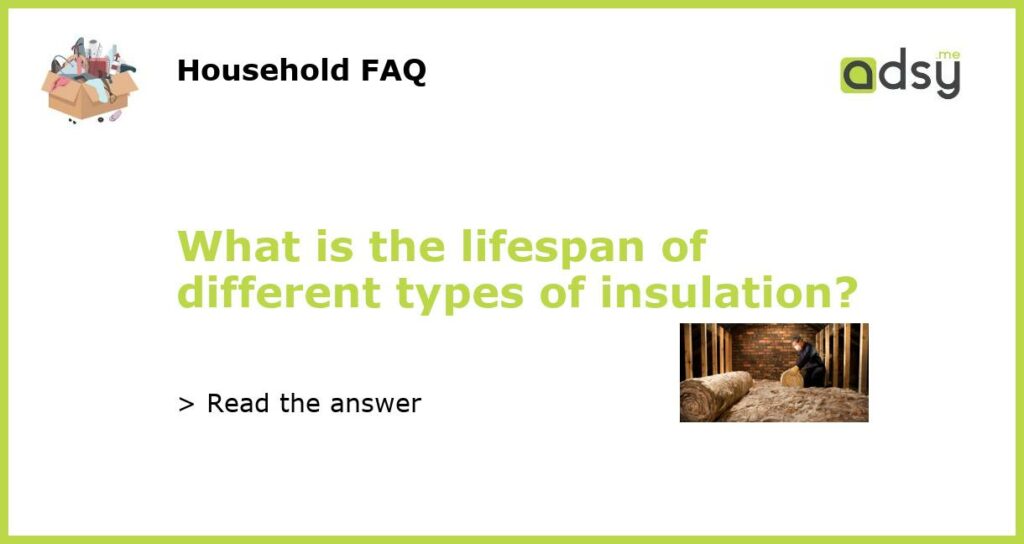Types of Insulation and Their Lifespans
Insulation is an essential component of a well-functioning home. It helps to regulate the temperature inside the house, keeping it cool in summer and warm in winter. However, insulation materials are not created equal, and their lifespans can vary. In this article, we will explore the lifespan of different types of insulation and discuss how to prolong their efficiency.
Fiberglass Insulation
Fiberglass insulation is one of the most common types of insulation found in homes. It is made from fine glass fibers and typically comes in rolls or batts. The average lifespan of fiberglass insulation is around 30 to 50 years. With proper installation and maintenance, it can last even longer.
To ensure the longevity of fiberglass insulation, it is crucial to keep it dry. Moisture can reduce its effectiveness and lead to mold growth. Proper ventilation and sealing any air leaks can help prevent moisture buildup. Additionally, regular inspection for any signs of damage or deterioration is also recommended.
Spray Foam Insulation
Spray foam insulation is a popular choice because of its excellent insulating properties and ability to seal air leaks. It is typically made from a combination of chemicals that react when sprayed, expanding and forming a solid foam. The lifespan of spray foam insulation is approximately 50 years or more.
One of the advantages of spray foam insulation is its durability. It does not sag or settle over time, maintaining its effectiveness for decades. However, UV exposure can cause degradation to spray foam insulation, so it is crucial to protect it by applying a protective coating or covering. Regular inspections for any signs of damage or wear are also recommended.
Cellulose Insulation
Cellulose insulation is an eco-friendly option made from recycled paper and treated with chemicals to resist pests and fire. It is commonly blown into attics and wall cavities. The lifespan of cellulose insulation is around 20 to 30 years.
To maximize the lifespan of cellulose insulation, it is essential to keep it dry and prevent moisture buildup. Moisture can lead to mold growth and reduce its effectiveness. Proper ventilation and sealing any air leaks can help prevent moisture-related issues. Regular inspections and maintenance can also help identify and address any damage or deterioration.
Mineral Wool Insulation
Mineral wool insulation is made from natural rock or blast furnace slag. It comes in batts or loose-fill form and provides excellent thermal and sound insulation. The lifespan of mineral wool insulation is approximately 50 years.
To maintain the efficiency of mineral wool insulation, it is important to keep it dry and prevent moisture buildup. Moisture can lead to mold growth and reduce its effectiveness. Proper ventilation and sealing any air leaks can help prevent moisture-related issues. Regular inspections and maintenance are also recommended to address any signs of damage or wear.
Aerogel Insulation
Aerogel insulation is one of the most advanced and efficient insulation materials available. It is a lightweight material with low thermal conductivity. While aerogel insulation is relatively new, it is expected to have a lifespan of 50 years or more.
To ensure the longevity of aerogel insulation, it is important to protect it from UV exposure, moisture, and physical damage. Applying a protective coating or covering can help shield it from UV rays, and proper ventilation and sealing any air leaks can prevent moisture-related issues. Regular inspections and maintenance are also recommended to address any signs of damage or wear.
The lifespan of different types of insulation varies, with fiberglass insulation lasting around 30 to 50 years, spray foam insulation lasting 50 years or more, cellulose insulation lasting 20 to 30 years, mineral wool insulation lasting 50 years, and aerogel insulation expected to last 50 years or longer. Proper installation, maintenance, and addressing any signs of damage or wear can help extend the lifespan of insulation materials. Ensuring proper ventilation, preventing moisture buildup, and protecting insulation from UV exposure are crucial for maintaining their effectiveness over time.

